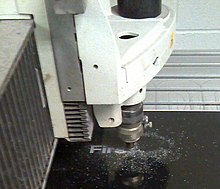Corian
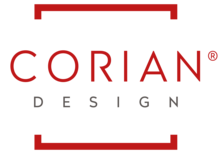
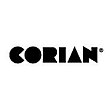
Corian is a brand of solid surface material created by DuPont. Its primary use is as a countertop and benchtop surface, though it has many other applications. It is composed of acrylic polymer and alumina trihydrate (ATH), a material derived from bauxite ore. Corian is the original material of this type, created by DuPont scientists in 1967.[1] A number of direct solid surface competitors to Corian have emerged since the expiration of DuPont’s patent on solid surfaces.
Corian is manufactured in three thicknesses: 6 millimetres (0.24 in), 12 millimetres (0.47 in), and 19 millimetres (0.75 in). Most Corian is manufactured at a DuPont facility near Buffalo, New York.[2] Cross-section cuts show consistent color and particulate patterning evenly distributed throughout the material, giving rise to the category name "solid surface".
Corian must be sold and installed by a DuPont certified fabricator; such installations come with a 10-year warranty covering both product and installation, for interior residential applications.[3]
History[]
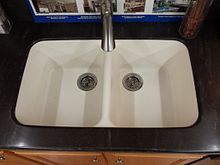
Donald Slocum, a DuPont chemist, is credited as inventing Corian solid surface in 1967.[4] His name appears on the patent issued in October 1968.[5] The product was first introduced for sale in 1971, at the National Association of Home Builder's meeting in Houston, Texas.[1]
Originally conceived as a kitchen and bath material available in a single color, Corian is manufactured and delivered in more than 100 colors.[6]
In 2013, the company announced its Endless Evolution initiative in an effort to improve the material and find additional applications for its use.[7] As part of this initiative, in 2014 DuPont introduced its "Deep Color" technology.[8] The enhancement allows for the material to be created in deeper, darker colors that are more resistant to scratches and cuts than earlier generation Corian material.[9]
In 2017, Corian marked its fiftieth year with a new look and marketing campaign.[10] Its renewed visual identity and logo was designed and developed by Italian branding agency GBR Design.[11] [12]
Product lines[]
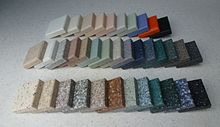

DuPont has issued various sub-branded releases of the material which contain unique design elements or methods of manufacture. Notably these have included:
- Corian Private Collection: First colors introduced in 2002; this product line is inspired by the randomness of patterns found in nature. Some colors and patterns in this product line resemble stone and other natural materials and all colors have complex non-repeating patterns not found in other Corian products.[13]
- Corian Terra Collection: First colors introduced in the 2000s; this product line contains between six and twenty percent recycled content.[14]
- Corian Illumination Series: First colors introduced in 2007; this product line is semi-translucent allowing for new designs calling for backlit applications.[15]
- Corian Metallics Series: First colors introduced in 2010; this product line contains particulate of gold and silver fleck to give the product a metallic appearance. This creates a depth that simulates movement and variation of color when the same installation is viewed from different angles.
- Martha Stewart Living Collection: First colors introduced in the United States in 2010; this product line is a collection of colors created by home improvement celebrity Martha Stewart.[16]
- Corian DeepColor Technology: First colors introduced in 2013; this product line uses new "Deep Color" technology to produce darker, more scratch-resistant colors.
- Corian Quartz: Rebranded in 2018, DuPont's Zodiaq quartz product was re-introduced as Corian Quartz. This product is an engineered stone and is not a solid surface material in a technical sense.
Material characteristics[]

Corian is:
- Non-porous
- Stain resistant
- Seamless appearance: In the fabrication process, joints can be made nearly invisible by joining the relevant pieces with Corian's own color-matched two-part acrylic adhesive. The pieces are clamped tightly together in order to express any excess adhesive. After the adhesive dries, the area is sanded and polished to create a near-seamless joint. This seamless appearance is a signature characteristic of the material.[17]
- Repairable and renewable: Cuts and scratches can be buffed out with a Scotch-Brite pad or orbital sander.
- Thermoformable: Flexible when heated, Corian can be shaped and molded into generally limitless forms which can be used in commercial and artistic projects through a process called thermoforming.
Heat resistance: the material is heat resistant up to 100 °C (212 °F), but can be damaged by excess heat. DuPont recommends the use of trivets when the material is installed in kitchens.[18]
Scratches: The material can be scratched, with scratches particularly noticeable on darker colors.
Corian does not lose its visual appearance or fade for many years, sometime decades.
Competitors[]
Corian is a type of premium decorative surface.[19] The expiration of DuPont's patent on solid surfaces helped facilitate a number of direct solid surface competitors to Corian.
Some major competing brands include the following:
- Aristech Avonite
- EVO Surfaces[20]
- Formica Group Solid Surfacing
- Hanwha Hanex
- Kerrock Kolpa
- Velstone
- Krion Porcelanosa Solid Surface[21]
- LG HI-MACS
- Lion Chemtech TRISTONE
- LOTTE Staron (fka Samsung Staron)
- Meganite
- Minerva
- Swan Swanstone
- Wilsonart Solid Surface
- Karonia Surfaces
- Corinthian Solid Surface
- Apollo Magna & Apollo Slab Tech
Corian and other solid surfaces also compete at a price point similar to other premium decorative surfaces. These other competitors include:
- Engineered stone
- Granite
- Marble
- Recycled glass countertops
- Stainless Steel
Safety[]
Safety of installed material[]
Corian meets or exceeds current emissions guidelines for volatile organic compounds (VOCs), hazardous air pollutants (HAPs) and is "Greenguard Indoor Air Quality Certified". Corian is nontoxic and nonallergenic to humans. It is free of heavy metals and complies with the EU Directive 2002/95EC on the Restriction of Hazardous Substances (RoHS). Its hygienic properties make it popular in installations where maintaining sanitary conditions is important (e.g. hospitals and restaurants).[22]
Fabricator safety[]
In 2014, the New England Journal of Medicine reported a case of a 64-year-old exercise physiologist who died from lung disease consistent with idiopathic pulmonary fibrosis after 16 years of exposure to Corian dust. Dust from Corian was found in the patient's shop of Corian fabrication and lung upon autopsy. The authors said that the case was consistent with Corian dust causing idiopathic pulmonary fibrosis, but did not prove causality.[23] DuPont scientists responded that exposure to other materials could not be ruled out, nor did they rule out it wasn’t caused from the dust which consists of aluminum trihydrate (ATH) derived from bauxite. Fabricators must properly protect themselves from fine Corian particulates generated during milling, and sanding. Fabricators should always wear a proper certified respirator and keep shop and environment clean of Corian dust at all times.
References[]
- ^ a b A Brief History of DuPont Corian (Streaming video). DuPont. 2013. Archived from the original on December 21, 2021 – via YouTube.
- ^ Carey, Elizabeth (October 10, 2013). "Buffalo: Corian Capital of the World". Buffalo, New York: WKBW-TV. Archived from the original on September 3, 2014. Retrieved June 28, 2014.
- ^ "The Corian Warranty and Zodiaq Warranty—Backed by DuPont". DuPont. Retrieved June 28, 2014.
- ^ "Dr. Donald Slocum". Obituaries. The New York Times. March 2, 2008. Retrieved June 28, 2014.
- ^ "The Birth of Solid Surface". Archived from the original on October 26, 2014. Retrieved June 28, 2014.
- ^ "The Colors of Corian". DuPont. Retrieved June 28, 2014.
- ^ "'Endless Evolution" Initiative in Europe Middle East and Africa". Saudi Projects Magazine. Archived from the original on September 4, 2014. Retrieved June 28, 2014.
- ^ "Corian 2.0 Dynamic and Evolutionary Interior Design". DuPont. Retrieved June 28, 2014.
- ^ "DuPont Corian launches DeepColour Technology to Develop Dark Colours for Solid-Surface Material". Dezeen. February 11, 2014. Retrieved June 28, 2014.
- ^ "The Corian® Brand marks its 50th Year with Whole New Look and Business Vision". Corian® Official Website. August 2, 2017. Retrieved August 2, 2017.
- ^ "DuPont Surfaces sceglie GBR Design come global brand identity agency per Corian". Brand News. May 12, 2017. Retrieved May 12, 2017.
- ^ "Case Study: Corian". GBR Design™. May 12, 2017. Retrieved May 12, 2017.
- ^ "Corian Private Collection Product Training". 2002. Archived from the original on September 3, 2014. Retrieved June 28, 2014 – via Docstoc.
- ^ "Achieve Sustainable Design Without Compromising Performance". DuPont. Retrieved June 28, 2014.
- ^ "DuPont Corian Illumination Series April 2008 Update" (PDF). Archived from the original (PDF) on May 12, 2014. Retrieved July 13, 2014.
- ^ Stewart, Martha (October 2, 2010). "Launching My New Kitchen Line With The Home Depot". The Martha Blog. Retrieved June 28, 2014.
- ^ "Corian: 40 Years, 40 Designers" (PDF). DuPont. April 2007. Retrieved June 28, 2014.
- ^ "Technical Specs for Corian Countertops". Archived from the original on September 3, 2014. Retrieved June 28, 2014.
- ^ Hetherman, Mike (December 22, 2013). "Top Stories of 2013 Countdown: #10—Ending Consumer Confusion in the Countertop Business". Retrieved June 28, 2014.
- ^ EVO Surfaces
- ^ KRION Porcelanosa Solid Surface
- ^ "Earn LEED Certification Points with DuPont Surfaces". DuPont. Retrieved June 28, 2014.
- ^ Raghu, Ganesh; Collins, Bridget F.; Xia, Daniel; Schmidt, Rodney; Abraham, Jerrold L. (May 29, 2014). "Pulmonary Fibrosis Associated with Aluminum Trihydrate (Corian) Dust". New England Journal of Medicine. 370 (2): 2154–2157. doi:10.1056/NEJMc1404786.
External links[]
- Brand name materials
- DuPont products
